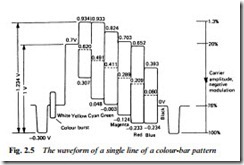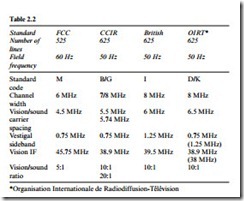COLOUR ENCODING
So far we have considered only the means of conveying the bright- ness information of a TV picture, and virtually all modern television, be it sourced from a home camera, a videorecorder, disc player or broadcast transmission, is in colour. It is necessary, then, to add further information to this basic luminance waveform to describe the colours in the picture. The colouring (chrominance) signal is kept separate from the luminance information throughout much of the circuitry of TV equipment: the two are separated early in the camera’s electronics and recombined at a late stage in the TV set or monitor. The derivation and processing of chrominance signals will be fully discussed in Chapters 6 and 7, and our concern here is with the chroma (for short) component of the composite video waveform.
Chroma signals are not carried in basic form over any but the shortest links. They are encoded and modulated onto a subcarrier which
by its phase and amplitude conveys all the necessary information to describe the colour in the picture. Because this subcarrier is carried on the video waveform the two signals are time-synchronised, and at any given moment the luminance signal and accompanying chroma signal together carry all the information required to precisely define the brightness and colour of a single picture element. By virtue of the elapsed time since the last sync pulse occurred the position of the picture element on the screen is also defined – its ‘longitude’ by the period since the last line pulse, and its ‘latitude’ by the period since the last field pulse.
For the PAL system used in the UK and much of Western Europe the colour subcarrier frequency is at 4.43361875 MHz: we shall shorten it here to 4.43 MHz for convenience. It is added to the luminance waveform as a sinusoidal wave whose amplitude is proportional to the degree of saturation of the colour being described, and whose phase, or timing, describes the hue of the colour. Since phase and timing are relative terms a reference must be provided against which to measure them. It takes the form of a ‘colour burst’ consisting of a ten-cycle sample of subcarrier frequency sitting on the back porch of the video waveform – Fig. 2.5. This waveform, drawn here as representing a colour-bar signal, is often known as a CVBS (Chroma, Video, Blanking and Syncs) signal, and is the standard form which will be found at the video input and output sockets of cameras, videorecorders, monitors and so on. Its level is invariably 1 V peak to peak, though as Fig. 2.5 shows, this refers to the luminance and sync components; a heavily saturated and bright picture section can take the waveform amplitude up to 1.234 V as is happening here on the first (yellow) bar. In conventional practice the signal is produced across an impedance of 75 Ω. The colour burst signal is also used as an amplitude reference for the chroma signals; its peak-to-peak amplitude is fixed at 0.3 V – the same as the sync pulses. Other characteristics of the chroma signal are given in Table 2.1.
VISION MODULATION
To carry a vision signal through a transmission channel, whatever the media may be, some form of modulation system is generally necessary. The carrier itself is usually a high-frequency r.f. wave, though light (visible or more usually infra-red) is increasingly being used: the medium here is generally fibre-optic cable. The carrier may be regarded as a ‘vehicle’ which is generated at the sending end and discarded at the receiver. There are various ways in which the basic
video signal (complete with colour subcarrier) can be impressed or modulated onto a carrier. For satellite transmissions, for twisted- pair cable distribution and for passage through the tape/head interface of a videorecorder, f.m. (frequency modulation) is used; for terrestrial broadcasting in the VHF and UHF bands a.m. (amplitude modulation) is used. Although r.f. modulators form no part of a TV receiver they are increasingly being used in the home – modulators operating in the region of UHF channel 36 are fitted to videorecorders, satellite boxes, disc players and home computers for easy interfacing with conventional TV sets; and more specialised modulators are used in the sound and vision circuits of videorecorders.
AM MODULATION
In terrestrial TV broadcasting an a.m. modulation system is used for the video signal. Here the carrier is a VHF or (especially in the UK) a UHF wave whose amplitude is varied in sympathy with the excursions of the composite video signal. Unlike an audio waveform the picture signal is asymmetrical, so either positive modulation or negative modulation can be adopted. Very early TV transmissions used positive modulation, but all current broadcasts, with the exception of French System L transmissions, are negatively modulated, so that sync pulses give rise to maximum carrier power, and peak white (plus chroma) corresponds to minimum carrier power. This has several advantages, a major one of which is the reduced effect of impulse interference on the reproduced picture: the sharp spikes characteristic of ignition and similar spurious pulses give rise, after
demodulation, to negative-going pulses on the recovered video signal. The resulting small black spots on the picture are less intrusive than the large defocused white spots which would result from an interference-laden positive-modulation signal.
The standard for an a.m. transmission is given in Fig. 2.5. Carrier power is 100% on sync pulse tips, falling to 76% on blanking and black level, 20% on peak white and 1.3% as an absolute minimum on fully colour-saturated bright scenes, again here represented by the yellow colour bar.



